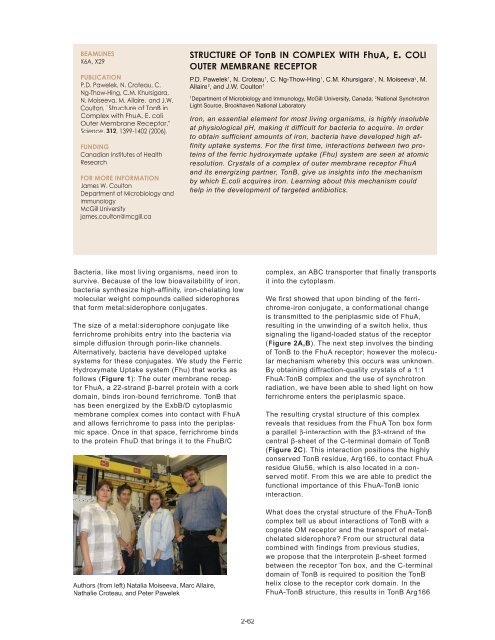NSLS Activity Report 2006 - Brookhaven National Laboratory
NSLS Activity Report 2006 - Brookhaven National Laboratory
NSLS Activity Report 2006 - Brookhaven National Laboratory
You also want an ePaper? Increase the reach of your titles
YUMPU automatically turns print PDFs into web optimized ePapers that Google loves.
BEAMLINES<br />
X6A, X29<br />
PUBLICATION<br />
P.D. Pawelek, N. Croteau, C.<br />
Ng-Thow-Hing, C.M. Khursigara,<br />
N. Moiseeva, M. Allaire, and J.W.<br />
Coulton, " Structure of TonB in<br />
Complex with FhuA, E. coli<br />
Outer Membrane Receptor,"<br />
Science, 312, 1399-1402 (<strong>2006</strong>).<br />
FUNDING<br />
Canadian Institutes of Health<br />
Research<br />
FOR MORE INFORMATION<br />
James W. Coulton<br />
Department of Microbiology and<br />
Immunology<br />
McGill University<br />
james.coulton@mcgill.ca<br />
Bacteria, like most living organisms, need iron to<br />
survive. Because of the low bioavailability of iron,<br />
bacteria synthesize high-affinity, iron-chelating low<br />
molecular weight compounds called siderophores<br />
that form metal:siderophore conjugates.<br />
The size of a metal:siderophore conjugate like<br />
ferrichrome prohibits entry into the bacteria via<br />
simple diffusion through porin-like channels.<br />
Alternatively, bacteria have developed uptake<br />
systems for these conjugates. We study the Ferric<br />
Hydroxymate Uptake system (Fhu) that works as<br />
follows (Figure 1): The outer membrane receptor<br />
FhuA, a 22-strand β-barrel protein with a cork<br />
domain, binds iron-bound ferrichrome. TonB that<br />
has been energized by the ExbB/D cytoplasmic<br />
membrane complex comes into contact with FhuA<br />
and allows ferrichrome to pass into the periplasmic<br />
space. Once in that space, ferrichrome binds<br />
to the protein FhuD that brings it to the FhuB/C<br />
Authors (from left) Natalia Moiseeva, Marc Allaire,<br />
Nathalie Croteau, and Peter Pawelek<br />
STRUCTURE OF TonB IN COMPLEX WITH FhuA, E. COLI<br />
OUTER MEMBRANE RECEPTOR<br />
P.D. Pawelek 1 , N. Croteau 1 , C. Ng-Thow-Hing 1 , C.M. Khursigara 1 , N. Moiseeva 2 , M.<br />
Allaire 2 , and J.W. Coulton 1<br />
1 Department of Microbiology and Immunology, McGill University, Canada; 2 <strong>National</strong> Synchrotron<br />
Light Source, <strong>Brookhaven</strong> <strong>National</strong> <strong>Laboratory</strong><br />
Iron, an essential element for most living organisms, is highly insoluble<br />
at physiological pH, making it difficult for bacteria to acquire. In order<br />
to obtain sufficient amounts of iron, bacteria have developed high affinity<br />
uptake systems. For the first time, interactions between two proteins<br />
of the ferric hydroxymate uptake (Fhu) system are seen at atomic<br />
resolution. Crystals of a complex of outer membrane receptor FhuA<br />
and its energizing partner, TonB, give us insights into the mechanism<br />
by which E.coli acquires iron. Learning about this mechanism could<br />
help in the development of targeted antibiotics.<br />
2-62<br />
complex, an ABC transporter that finally transports<br />
it into the cytoplasm.<br />
We first showed that upon binding of the ferrichrome-iron<br />
conjugate, a conformational change<br />
is transmitted to the periplasmic side of FhuA,<br />
resulting in the unwinding of a switch helix, thus<br />
signaling the ligand-loaded status of the receptor<br />
(Figure 2A,B). The next step involves the binding<br />
of TonB to the FhuA receptor; however the molecular<br />
mechanism whereby this occurs was unknown.<br />
By obtaining diffraction-quality crystals of a 1:1<br />
FhuA:TonB complex and the use of synchrotron<br />
radiation, we have been able to shed light on how<br />
ferrichrome enters the periplasmic space.<br />
The resulting crystal structure of this complex<br />
reveals that residues from the FhuA Ton box form<br />
a parallel β-interaction with the β3-strand of the<br />
central β-sheet of the C-terminal domain of TonB<br />
(Figure 2C). This interaction positions the highly<br />
conserved TonB residue, Arg166, to contact FhuA<br />
residue Glu56, which is also located in a conserved<br />
motif. From this we are able to predict the<br />
functional importance of this FhuA-TonB ionic<br />
interaction.<br />
What does the crystal structure of the FhuA-TonB<br />
complex tell us about interactions of TonB with a<br />
cognate OM receptor and the transport of metalchelated<br />
siderophore? From our structural data<br />
combined with findings from previous studies,<br />
we propose that the interprotein β-sheet formed<br />
between the receptor Ton box, and the C-terminal<br />
domain of TonB is required to position the TonB<br />
helix close to the receptor cork domain. In the<br />
FhuA-TonB structure, this results in TonB Arg166

















